Physical Address
304 North Cardinal St.
Dorchester Center, MA 02124
Physical Address
304 North Cardinal St.
Dorchester Center, MA 02124
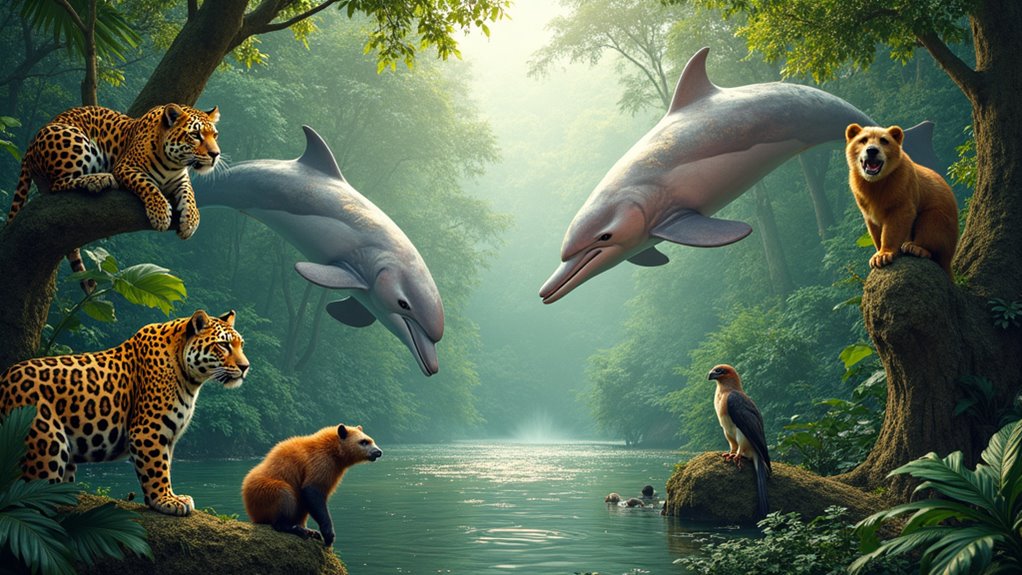
Hidden within the Amazon's emerald depths, these nine astonishingly rare creatures face extinction while scientists race against time to save them.
The Amazon rainforest shelters incredibly rare creatures including the silent harpy eagle, golden lion tamarin, elusive jaguar, and giant otter. You’ll also find the crimson-faced uakari monkey, vibrant poison dart frogs, gentle manatees, and the powerful electric eel. These species face mounting threats from deforestation, hunting, and climate change. Conservation efforts show promise, but these magnificent animals need urgent protection to survive in their rapidly changing home.
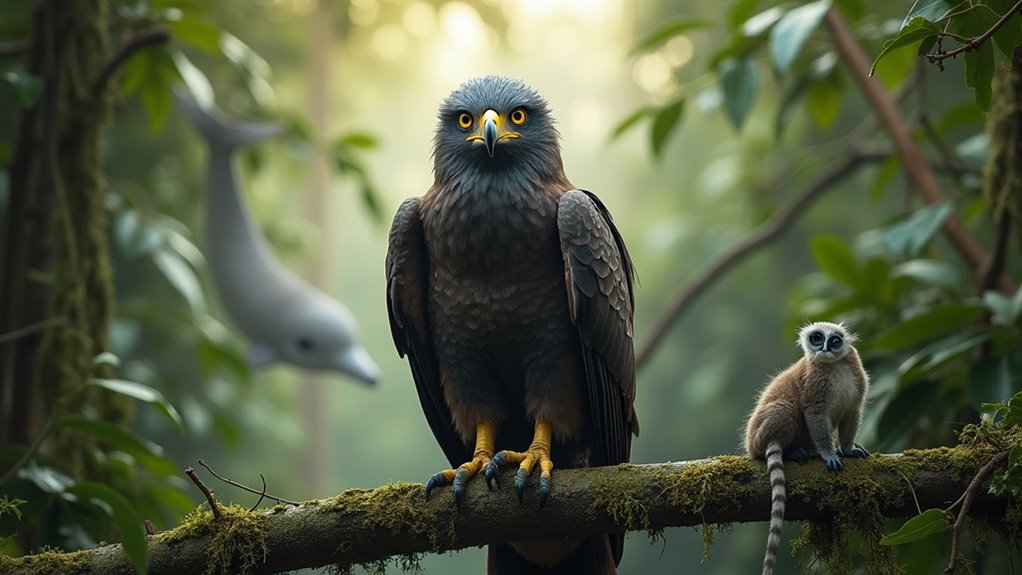
Deep within the lush Amazon rainforest, the harpy eagle reigns as one of the most formidable aerial predators you’ll ever encounter. With a wingspan reaching 8.2 feet and talons larger than a grizzly bear’s, these majestic birds silently patrol the mid to upper canopy levels.
The apex predator of Amazonian skies, with weapons more fearsome than a grizzly and wings that command respect.
You’ll find harpy eagles forming lifelong monogamous pairs, building their nests in towering kapok or ceiba trees. They’re stealth hunters, reaching speeds of 50 mph as they swoop down on sloths and monkeys. These powerful birds construct massive nests using over 300 branches that can measure six feet in diameter. Their exceptional eyesight helps them navigate dense vegetation while scanning for prey.
Unfortunately, these rainforest guardians face significant threats from habitat loss and hunting. Conservation efforts focus on preserving their tropical lowland habitat, where they play a vital role in controlling mesopredator populations.
Their rarity and power have made them culturally significant symbols throughout their range.
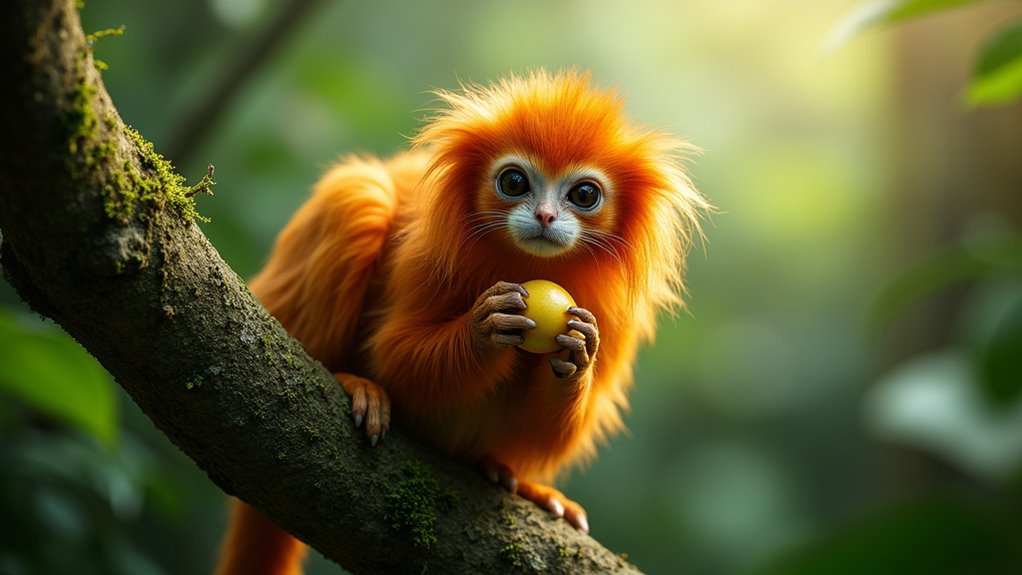
Adorned with a striking golden-orange mane that resembles a lion’s, the golden lion tamarin stands as one of the Amazon’s most visually mesmerizing and critically endangered primates.
You’ll find these small, intelligent creatures exclusively in Brazil’s Atlantic Forest, primarily in the São João River Basin.
Once teetering on extinction with just 200 individuals in the wild, conservation efforts have boosted their population to over 2,000 today.
Despite this progress, they remain endangered due to severe habitat fragmentation across their limited range.
These social primates face ongoing threats from deforestation, which isolates populations and reduces genetic diversity. This unique species has seen over 98% loss of its original habitat since Portuguese colonization began in 1500.
Conservation initiatives focus on reconnecting forest fragments through reforestation and establishing protected reserves.
With continued community involvement and international support, there’s hope for these flame-colored jewels of the forest.
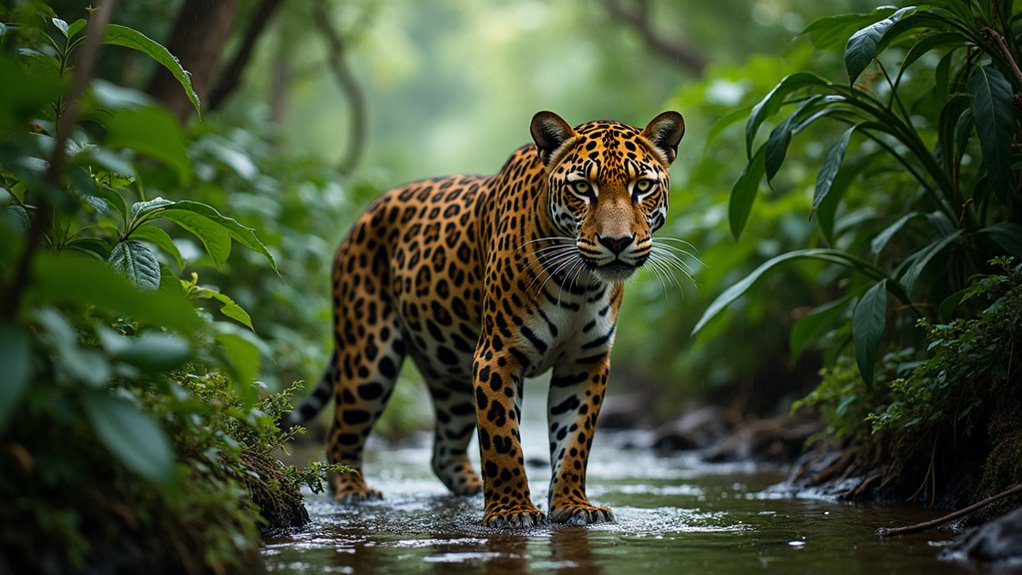
Revered as the mightiest cat in the Americas, the jaguar reigns as the Amazon rainforest’s apex predator while facing mounting threats to its survival. With distinctive spot patterns unique as human fingerprints, these powerful swimmers can crush bones with their formidable jaws.
You’ll find Brazil’s Amazon hosting nearly 50% of the world’s jaguars, with estimates reaching 79,000 individuals. Indigenous reserves shelter the majority of these cats, providing safer havens than other protected areas. Approximately 350 jaguars are killed or displaced annually due to human activities in the Amazon. Despite this protection, jaguar populations declined 1.8% in just five years due to hunting, deforestation, and wildfires.
When jaguars disappear, entire ecosystems suffer cascading effects. Their presence regulates prey populations like deer and capybaras, maintaining the Amazon’s delicate ecological balance.
Conservation efforts now prioritize areas based on both population size and threat levels.
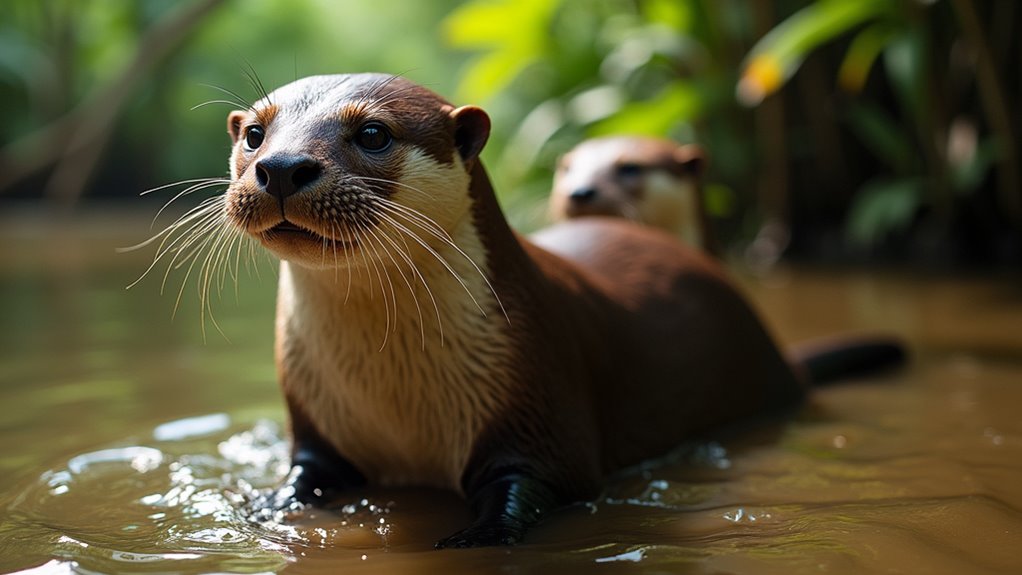
Exploring the pristine waterways of South America’s river systems, giant otters represent one of the Amazon’s most endangered and distinctive mammals. You’ll find these social creatures living in family groups of 3-10 members along freshwater rivers with stable, vegetation-rich banks where they dig communal dens.
With their water-repellent fur and athletic build, they’re perfectly adapted for their aquatic lifestyle. Each giant otter can be identified by its unique white patch extending from the jaw to chest. They’re diurnal hunters, cooperatively pursuing fish in clear, shallow waters.
When you’re near their territory, you might hear their complex vocalizations—hums, whistles, and screams—which they use to communicate within their tight-knit families.
Despite their playful nature and ecological importance as keystone species, giant otters face serious threats from habitat destruction, water pollution, and poaching, pushing these river giants toward extinction.
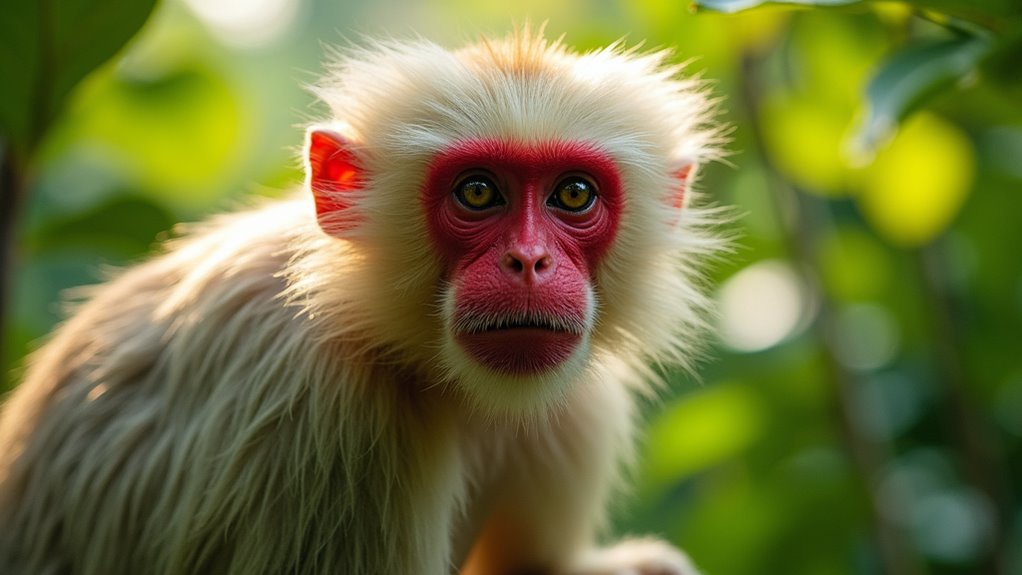
With its startlingly crimson face set against ruddy fur, the red-faced uakari is especially noticeable as one of the Amazon’s most distinctive and vulnerable primates.
You’ll find these social creatures in Brazil, Peru, and Colombia’s várzea forests, where they form groups of 10-30 individuals that occasionally merge into assemblies of up to 100.
Their bright red face isn’t just for show—it indicates good health and proper nutrition.
As herbivores, they primarily feast on fruits and leaves, playing a pivotal role in seed dispersal throughout their flooded forest habitats. Their fangs are developed specifically to break through thick fruit skins in their palm-dominated habitats.
Despite being protected in some areas, these short-tailed monkeys face mounting threats from deforestation and hunting.
Their specialized habitat needs make them particularly vulnerable to environmental changes, highlighting the urgent need for cross-border conservation efforts.
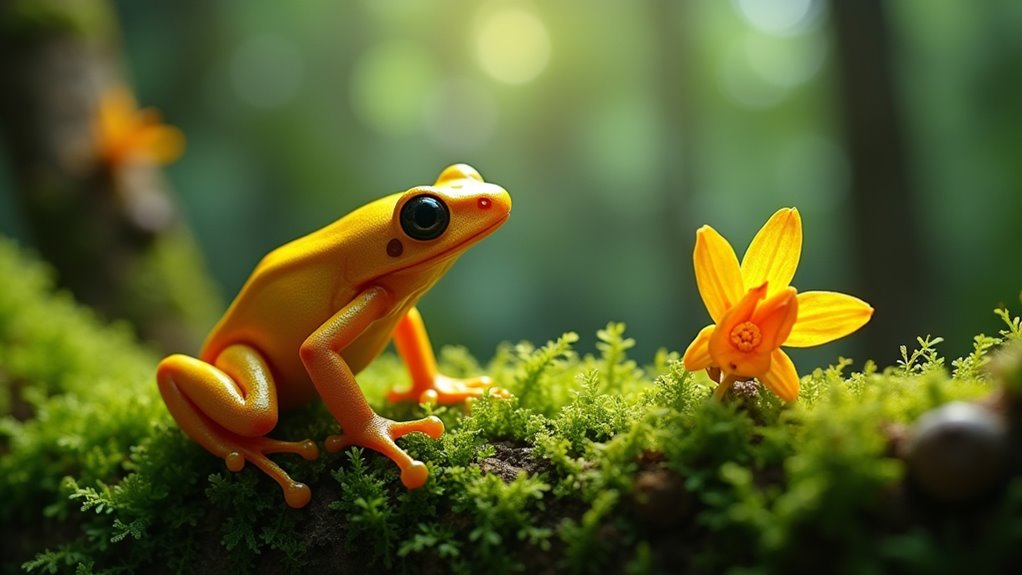
Among the Amazon’s most enthralling creatures, poison dart frogs command attention with their dazzling array of colors that seem almost too vibrant to be natural. These tiny amphibians boast striking yellows, reds, blues, and greens that serve as warning signals to potential predators.
You’ll find over 350 species throughout the Neotropical regions, with most originating from at least fourteen ancestral dispersals from the Andes Mountains some 23 million years ago. Their toxicity isn’t innate but derives from their diet of ants and mites containing alkaloid compounds. Their remarkable parental care includes carrying tadpoles on their backs to suitable water sources, often within bromeliads.
Despite their fierce chemical defenses, these frogs face mounting threats from habitat destruction, climate change, and the illegal pet trade. Their presence indicates ecosystem health, making them crucial bioindicators.
Conservation efforts focus on protecting their sensitive microhabitats and monitoring populations to preserve these vibrant defenders of the forest floor.
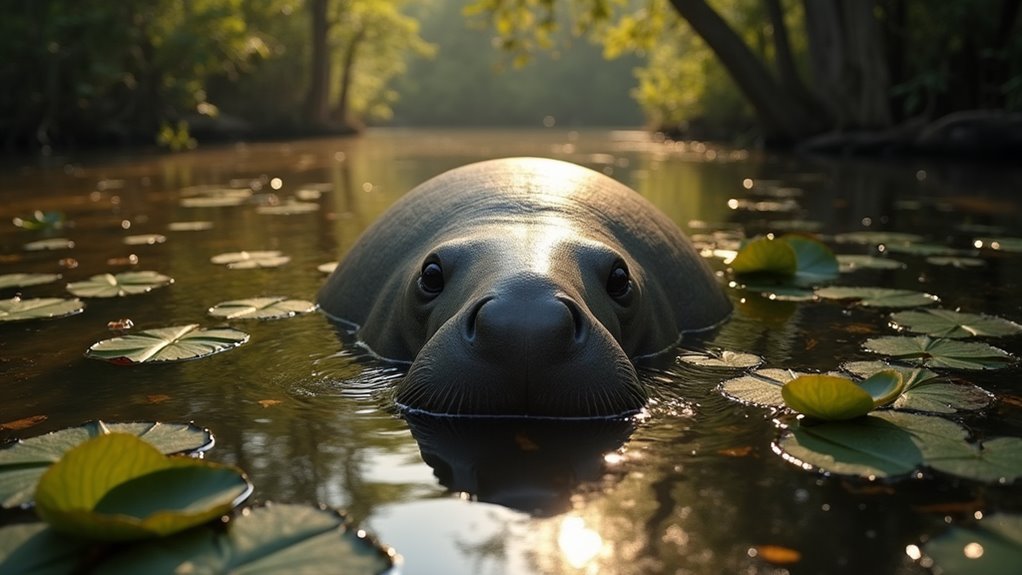
While poison dart frogs dazzle with their vivid colors, the Amazonian manatee offers a stark contrast in both appearance and demeanor. These gentle giants—the smallest of all manatee species—quietly navigate the freshwater rivers and lagoons of the Amazon basin with their brownish-gray, wrinkled skin and distinctive white chest patches.
You’ll find these solitary herbivores moving seasonally through murky waters, following flood patterns while searching for dense aquatic vegetation. Unlike most mammals, these aquatic creatures have teeth that undergo horizontal replacement throughout their entire lives. They’re nocturnal creatures, consuming up to 33 pounds of leafy plants daily to maintain their robust frames.
Despite their peaceful nature, Amazonian manatees face serious threats from hunting and habitat loss. Their population continues to decline as deforestation and climate change alter water levels and temperatures.
Conservation efforts and public awareness are vital to protecting these rare freshwater mammals from extinction.
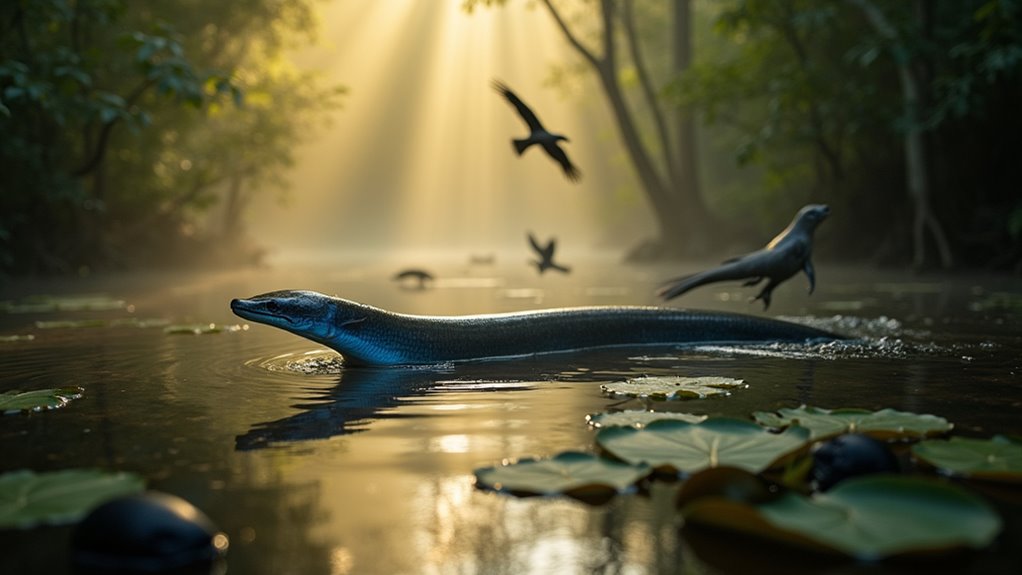
The electric eel stands as one of the Amazon’s most fascinating paradoxes—neither a true eel nor merely electric, but rather a knife fish with remarkable bioelectric capabilities.
You’ll find these living batteries exclusively in the slow-moving, murky waters of the Amazon and Orinoco basins, where they’ve mastered survival in oxygen-poor environments.
These apex predators can grow over 2 meters long and deliver shocks up to 600 volts—enough to stun both prey and potential threats.
Electric eels unleash nature’s taser—600 volts of bioelectric power that immobilizes victims in the murky Amazonian depths.
They’ve adapted to breathe air directly from the surface, taking 80% of their oxygen needs this way.
With nearly 80% of body mass dedicated to specialized electrical organs, these creatures are essentially swimming power plants that have evolved over millions of years.
Unfortunately, deforestation, pollution, and hydroelectric projects threaten their specialized habitats.
As climate change alters precipitation patterns across South America, these remarkable creatures face increasing challenges to their survival in the Amazon’s complex aquatic ecosystems.
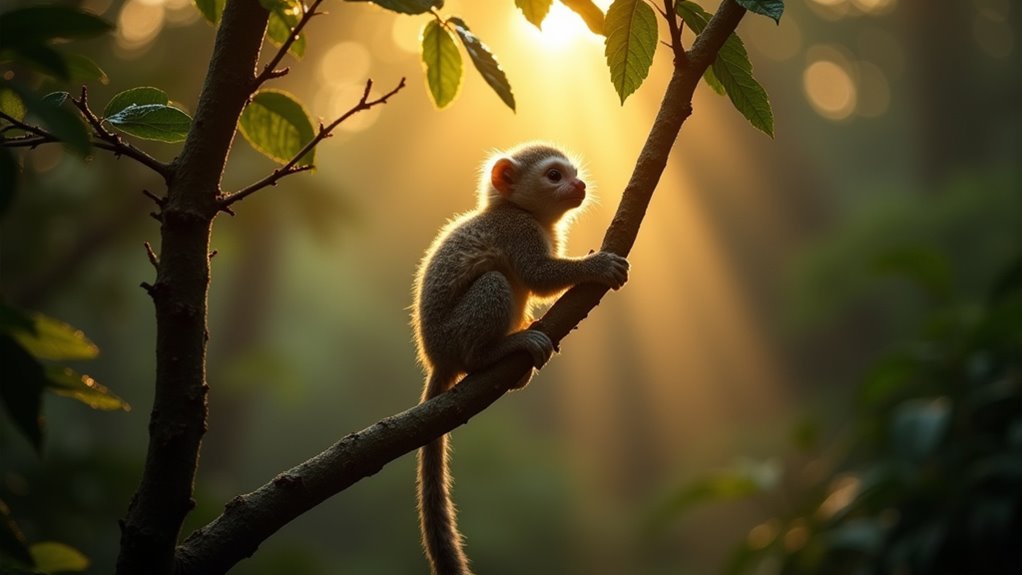
Despite harboring some of Earth’s most extraordinary creatures, the Amazon rainforest faces unprecedented conservation challenges that threaten its rarest inhabitants.
Deforestation, climate change, and the illegal wildlife trade have devastated populations of jaguars, pink dolphins, and hyacinth macaws. The Uakari monkey faces particular danger due to its critical role in seed dispersal throughout the rainforest ecosystem. As human settlements expand, conflicts between farmers and wildlife intensify.
Yet, there’s hope on the horizon. Protected areas, community-led conservation, and international cooperation are making a difference. You’ll find successful reforestation projects restoring critical habitats, while conservation corridors connect fragmented landscapes.
Technological innovations like drone monitoring help track deforestation in real-time.
The future of Amazon conservation depends on strengthened laws, sustainable practices, and your awareness. By supporting ecotourism and conservation organizations, you’re contributing to the survival of the rainforest’s most vulnerable species.
These nine rare Amazonian creatures need your attention and protection now more than ever. As you’ve seen, they’re facing challenges that would make even the strongest environmentalist weep oceans of tears. By supporting conservation efforts, reducing your carbon footprint, and spreading awareness, you’re directly contributing to their survival. Remember, what happens in the Amazon impacts us all—these magnificent animals aren’t just rare; they’re irreplaceable treasures of our shared planet.